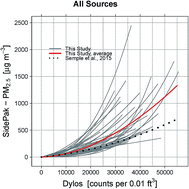Determining PM2.5 calibration curves for a low-cost particle monitor: common indoor residential aerosols†
Abstract
Real-time particle monitors are essential for accurately estimating exposure to fine particles indoors. However, many such monitors tend to be prohibitively expensive for some applications, such as a tenant or homeowner curious about the quality of the air in their home. A lower cost version (the Dylos Air Quality Monitor) has recently been introduced, but it requires appropriate calibration to reflect the mass concentration units required for exposure assessment. We conducted a total of 64 experiments with a suite of instruments including a Dylos DC1100, another real-time laser photometer (TSI SidePak™ Model AM-510 Personal Aerosol Monitor), and a gravimetric sampling apparatus to estimate Dylos calibration factors for emissions from 17 different common indoor sources including cigarettes, incense, fried bacon, chicken, and hamburger. Comparison of minute-by-minute data from the Dylos with the gravimetrically calibrated SidePak yielded relationships that enable the conversion of the raw Dylos particle counts less than 2.5 μm (in #/0.01 ft3) to estimated PM2.5 mass concentration (e.g. μg m−3). The relationship between the exponentially-decaying Dylos particle counts and PM2.5 mass concentration can be described by a theoretically-derived power law with source-specific empirical parameters. A linear relationship (calibration factor) is applicable to fresh or quickly decaying emissions (i.e., before the aerosol has aged and differential decay rates introduce curvature into the relationship). The empirical parameters for the power-law relationships vary greatly both between and within source types, although linear factors appear to have lower uncertainty. The Dylos Air Quality Monitor is likely most useful for providing instantaneous feedback and context on mass particle levels in home and work situations for field-survey or personal awareness applications.


 Please wait while we load your content...
Please wait while we load your content...